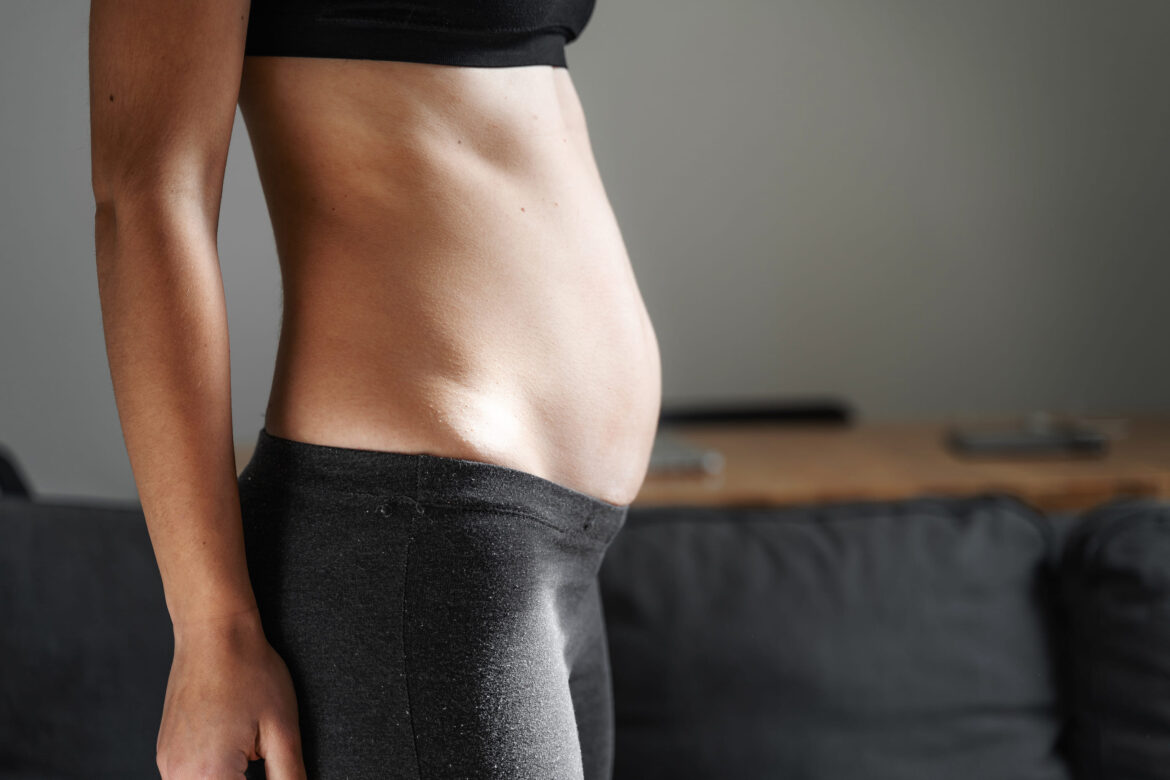Diastasis recti is the partial or complete separation of the rectus abdominis muscles, also known as the “abdominal muscle” or simply the “abs”. Diastasis recti is very common during pregnancy or postpartum due to the stretching of the “abs” when the uterus expands during pregnancy.[1]
Symptoms of Diastasis Recti
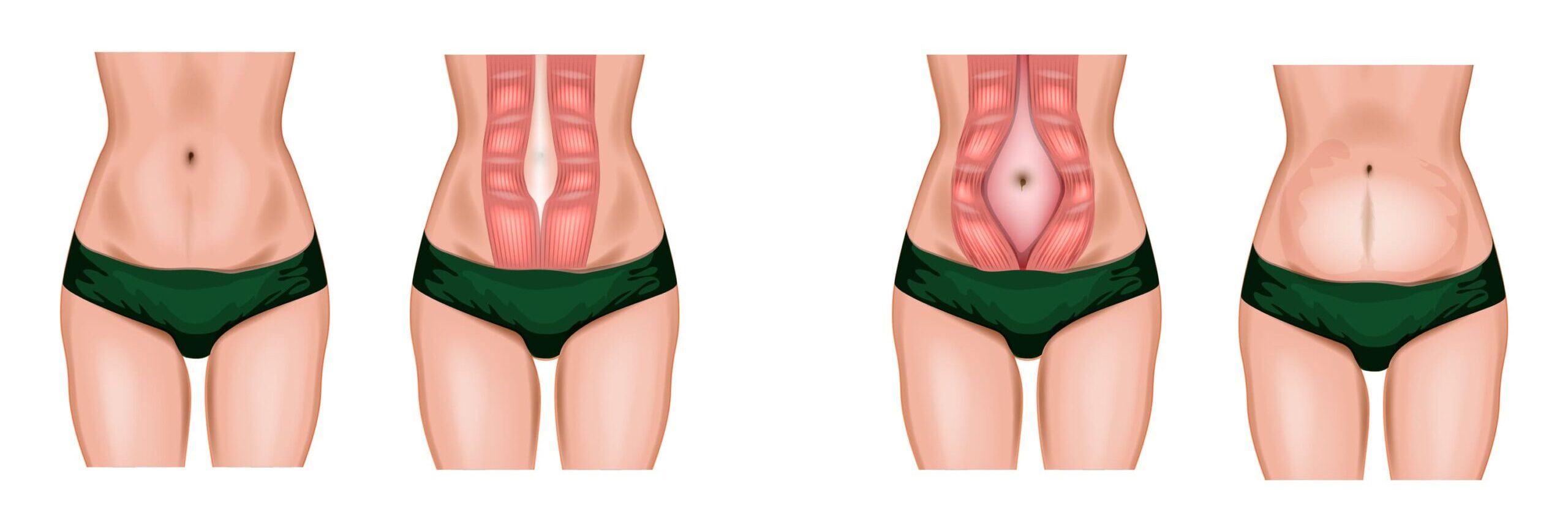 Normal abdomen (left) Diastasis Recti (right)
Normal abdomen (left) Diastasis Recti (right)
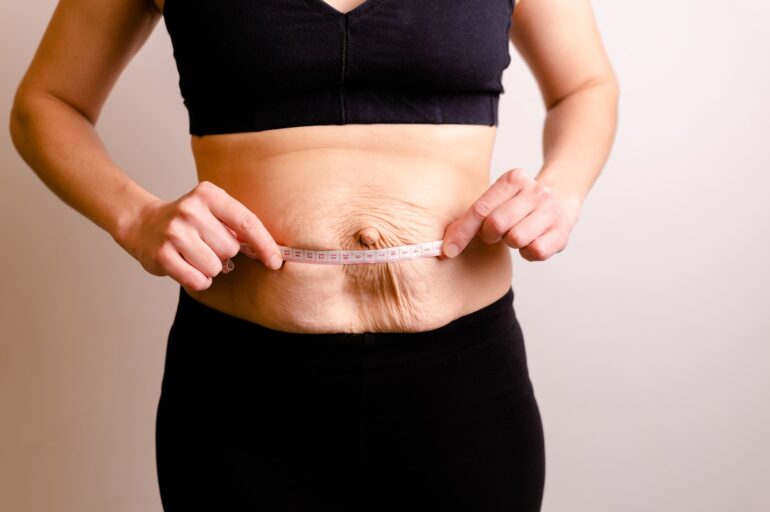
Front view of woman measuring the distance for Diastasis Recti
Symptoms of Diastasis Recti often manifest with a noticeable bulge in the stomach, creating the appearance commonly referred to as a “mummy tummy.” Additional symptoms may include a soft or jelly-like sensation around the belly button, the occurrence of coning or doming when abdominal muscles are engaged or contracted, challenges in lifting objects, lower back pain, compromised posture, and issues such as constipation or bloating. Identifying these symptoms is crucial for early recognition and appropriate management of diastasis recti. [2]
Causes of Diastasis Recti and its Risk Factors
The primary cause of Diastasis Recti is the exertion of excessive inner-abdominal pressure. This often occurs during pregnancy, particularly when pushing during delivery. Additional risk factors contributing to the development of Diastasis Recti include chronic straining, a family history of the condition, improper lifting techniques, and engaging in exercises that involve excessive abdominal loading.[3]
Self-assessment for Diastasis Recti [4]
-
- Lie on your back with your feet flat on the floor/bed and your knees bent.
- Place your fingers in a horizontal line in the centre of your abdomen, just above the belly button.
- Tuck your chin down onto your chest and round your shoulders forward slightly off the floor/bed. This will increase the tension in your abdominal muscles. It is not a sit up.
- Gently try to feel the edges of your abdominal muscles.
- With this increased tension, assess how many fingers fit into the gap between the two bands of muscles.

A separation of 2.5cm (two to three fingers) is considered normal. Immediately after delivery, the gap can be wider, which is also normal. If the gap is more than three fingers or you notice persistent “doming,” it is advisable to discuss your concerns with your doctor for a proper diagnosis and appropriate care recommendations.[4]
Treating Diastasis Recti with TCM
i. Acupuncture
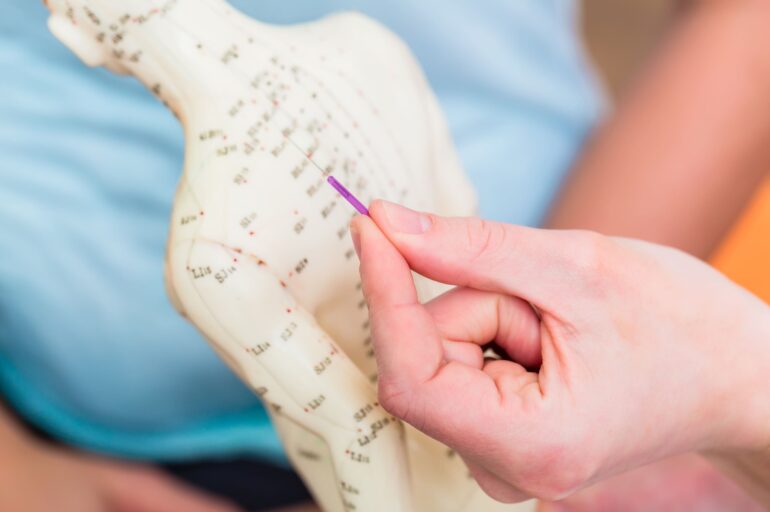
Diastasis Recti, characterised by the partial or complete separation of the rectus abdominis muscles, is viewed in Traditional Chinese Medicine (TCM) as a muscle condition. According to TCM principles, the health and development of our muscles and tissues are governed by the “Spleen“. The “Spleen” is also one of our body’s major organs that is essential to a healthy digestive system.
Our stomach muscles have four meridians or channels that run through our abdomen. These channels carry our body’s circulation – Blood and Qi, which is the TCM concept of our body’s vital energy. Acupuncture can help unblock areas of stagnation, promote Blood and Qi circulation and restore the healthy flow of blood and energy through the meridians. Increasing the proper function of these meridians can help heal and strengthen our abdominal muscles.[5]
There is evidence suggesting that acupuncture, along with physical training, may be effective in treating postpartum diastasis recti [6]. Additionally, research indicates that electro-acupuncture can be a beneficial approach for improving postpartum Diastasis Recti symptoms [7]. Acupuncture focuses on specific acupoints to enhance the flow of Qi and Blood in our “Conception vessel”, “Stomach,” and “Spleen.” Examples of these acupoints include 中脘 Zhong Wan (CV12), 下脘 Xia Wan (CV10), 气海 Qi Hai (CV6), 天枢 Tian Shu (ST25), 大横 Da Heng (SP15), 足三里 Zu San li (ST36), and 三阴交 San Yin Jiao (SP6). These acupoints are strategically selected to support the restoration of balance and energy flow in the affected areas, contributing to the management of Diastasis Recti.
ii. Electro-Lymphatic Therapy (ELT)
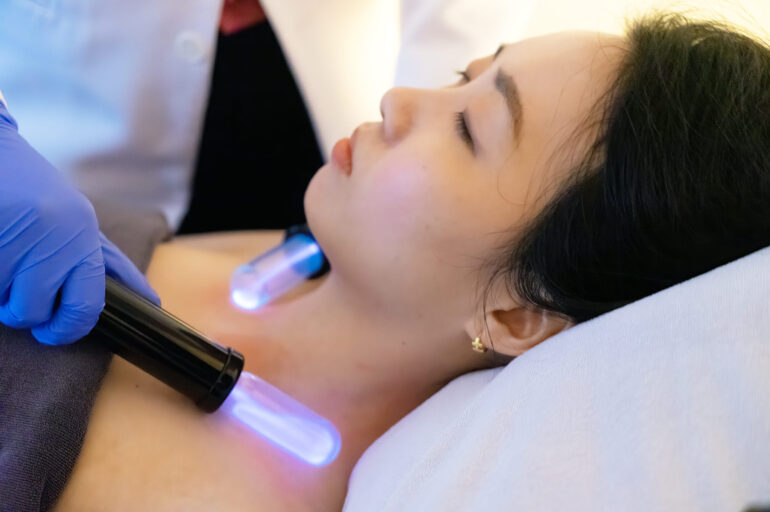
ELT is a painless and non-invasive therapy that stimulates better lymphatic flow and drainage and enhances overall blood circulation. Improved blood circulation promotes healing by strengthening the abdominal muscles. This condition is sometimes accompanied by lower back pain and digestive issues like constipation and bloating. Enhanced circulation can help promote the body’s natural healing processes and relieve associated discomforts.
iii. Cell Pro Therapy
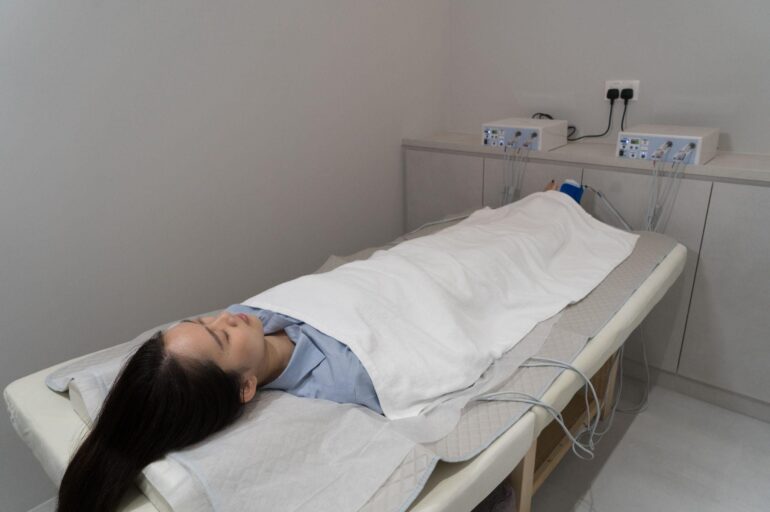
Cell Pro Therapy introduces negative ions, which are negatively charged particles with antioxidant properties, to our body. These negative ions play a role in enhancing the body’s self-defence mechanism by improving our body’s ability to repair itself. It can also improve cell oxygenation to enhance immunity, cellular function, and cellular metabolism. These combined effects support the recovery of abdominal muscles, making Cell Pro Therapy a comprehensive approach to promoting overall well-being and the healing process.
iv. Far-infrared Therapy (FIR)
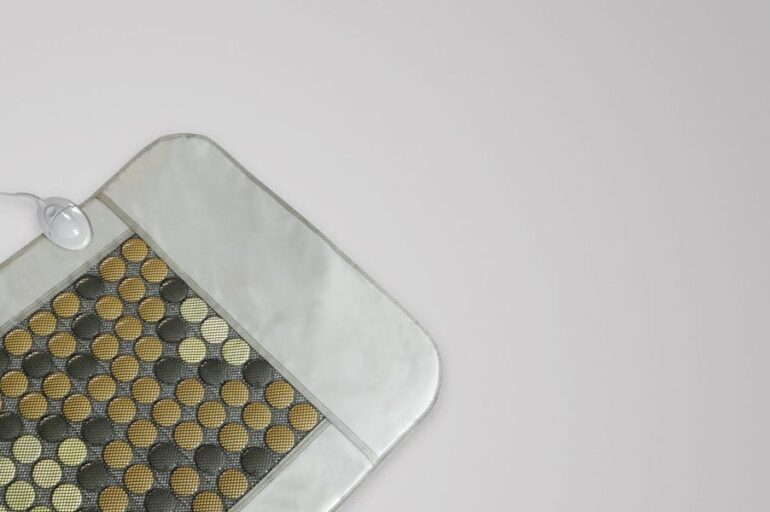
Far-Infrared Therapy (FIR) elevates skin temperature and penetrates deeper layers of our body, promoting blood circulation and muscle relaxation. The improved circulation and relaxation of muscles can help promote muscle recovery.
Read more about What is Far-Infrared Therapy (FIR) And What Does It Do?
Dietary & lifestyle recommendations
It’s essential to be cautious of movements that push the abdominal wall forward, as they can exacerbate damage to your abdominals. Be mindful of how you are using your abdominals as you go about your day.
Exercises to avoid
- Crunches or sit-ups of any kind.
- Planks or push-ups (unless using modifications).
- Downward dog, boat pose and other yoga poses.
- Double leg lifts, scissors and other Pilates moves.
- Any exercise that causes your abdominals to bulge, cone or dome. [8]
Things to avoid
- holding your baby on one hip.
- lifting or carrying heavy loads.
- coughing without supporting your ab muscles. [9]
Adhering to these guidelines will support the healing process and contribute to the effective recovery of your abdominal muscles.
Self care tips – Early Stage Exercises (Post-partum)
i. Abdominal breathing
(You can do this exercise lying down with knees bent, sitting or standing)
- Rest one hand on your tummy and take a deep breath in.
- As you breathe out, draw in/tighten your pelvic floor muscles and your abdominal muscles.
- As you breathe in, relax your pelvic floor muscles and your abdominal muscles.
- Repeat up to 10 times.

Example of abdominal breathing while lying on your back
ii. Pelvic tilts
(Perform lying down with bent knees or in a sitting position)
- As you breathe out, gently draw in your abdominal muscles and pelvic floor and flatten your spine into the bed or back of the chair. This will tilt your pelvis backwards.
- As you breathe in, tilt your pelvis forwards and relax your abdominal muscles and pelvic floor
- Repeat up to 20 times.

Example of pelvic tilts while lying down with bent knees
Please note that these exercises are a guide and an individualised assessment and exercise programme is sometimes required.[10]
Your healing is the most important!
TCM aims to restore the natural balance of Yin-Yang, as well as Qi and Blood in the body, addressing various health conditions through different TCM treatments. By using acupuncture to improve circulation and promote healing, the root cause of Diastasis Recti could be addressed.
Additionally, to accelerate the recovery progress and complement TCM treatments through a modern approach, physicians at ORG may also prescribe tech-enhanced therapies like Electro-Lymphatic Therapy, Cell Pro Therapy, and Far Infrared Therapy based on their understanding of the western pathogenesis of Diastasis Recti. The combination of TCM and tech-enhanced treatments, along with recommendations on dietary and lifestyle practices, could target different aspects of Diastasis Recti holistically.
At Oriental Remedies Group, most of our physicians are trained in both Biomedical Science and TCM at Nanyang Technological University (Singapore) and China for a minimum of 5-8 years before being certified to practise in Singapore. If you or your loved one is looking for a holistic way to care for yourself during this period, consult our physicians at +65 8087 0486 for a targeted treatment plan.
—
This article is written by Physician Kerry Chen (Oriental Remedies Group, Singapore), a registered TCM physician certified by the Traditional Chinese Medicine Practitioners Board (TCMPB).
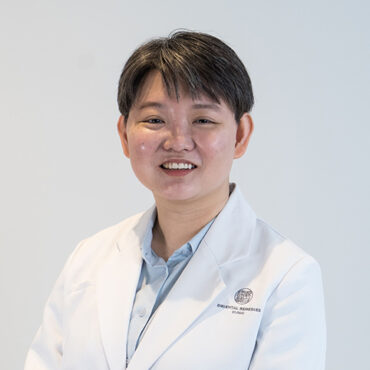
Disclaimer:
The content on this page is for information and educational purposes only. Such medical information may relate to disease, injury, drugs and other treatments, medical devices and/or health products. Medical information does not amount to advice, and if advice is needed an appropriate professional help should be sought. The disclaimer asserts that no warranties or representations are given in respect of the medical information, and that the website operator should not be held liable if a user suffers any injury or loss after relying upon the medical information.
Any devices used for technology-enhanced therapies are intended for use only for general well-being purposes or to encourage or maintain a healthy lifestyle, and is not intended to be used for any medical purpose (such as the detection. diagnosis, monitoring, management or treatment of any medical condition or disease). Any health-related information provided by this device or software should not be treated as medical advice.
References:
[1]https://www.healthline.com/health/diastasis-recti#TOC_TITLE_HDR_1
[2]https://my.clevelandclinic.org/health/diseases/22346-diastasis-recti
[3]https://my.clevelandclinic.org/health/diseases/22346-diastasis-recti
[4]https://my.clevelandclinic.org/health/diseases/22346-diastasis-recti
[5] https://my.clevelandclinic.org/health/diseases/22346-diastasis-recti
[6] https://pubmed.ncbi.nlm.nih.gov/34966711/
[7] https://www.frontiersin.org/articles/10.3389/fpubh.2022.1003361/full
[8] https://my.clevelandclinic.org/health/diseases/22346-diastasis-recti
[9] https://www.healthline.com/health/diastasis-recti#what-to-avoid

